The 4 Most Common Signs of Termites in Maryland Homes
Termites may be one of the hardest things to detect whether they are lurking in your home or not.
They could be in your walls or foundation, and you might not even know it. They are pretty sneaky, and that’s just not a great feeling, particularly if you have a sense they are in your home.
You might think you have termites because of damage or weird sounds or sights that make you suspicious. Your home is one of your single biggest investments, and you’re not about to let little pests take it out from under you.
Use This Tool to Compare Your Local Pest Control CompaniesWe understand your concern. Termites cause $50 billion in damage to homes and buildings annually, so they are certainly not something to ignore.
But there are signs of termite infestation you can focus on to confirm your suspicions or ease your worries.
Here is some guidance for spotting termites in Maryland so you can focus your efforts.
4 Signs of Termites
First, while many insects have a season or time of year when they appear most active, termites can be active in your home all year long.
But they are known to swarm in April. What encourages termites to swarm is the warming weather, as well as rain. They will typically swarm after rainfall to ensure they stay hydrated during the process.
Termites swarm when they go in search of mates and to establish a new colony. Colonies themselves typically don’t swarm until they’ve become established; this can take about 3 years.
But other than the possibility of seeing more termites moving about in spring, you may not see termites at all until the damage is done. That’s why it’s important to keep an eye out for these signs of termites in your house.
1. Flying Termites in Spring
So, as we just mentioned, termites tend to swarm In April and May.
This is the time when they fly into the air, drop to the ground, shed their wings, and seek out a mate.
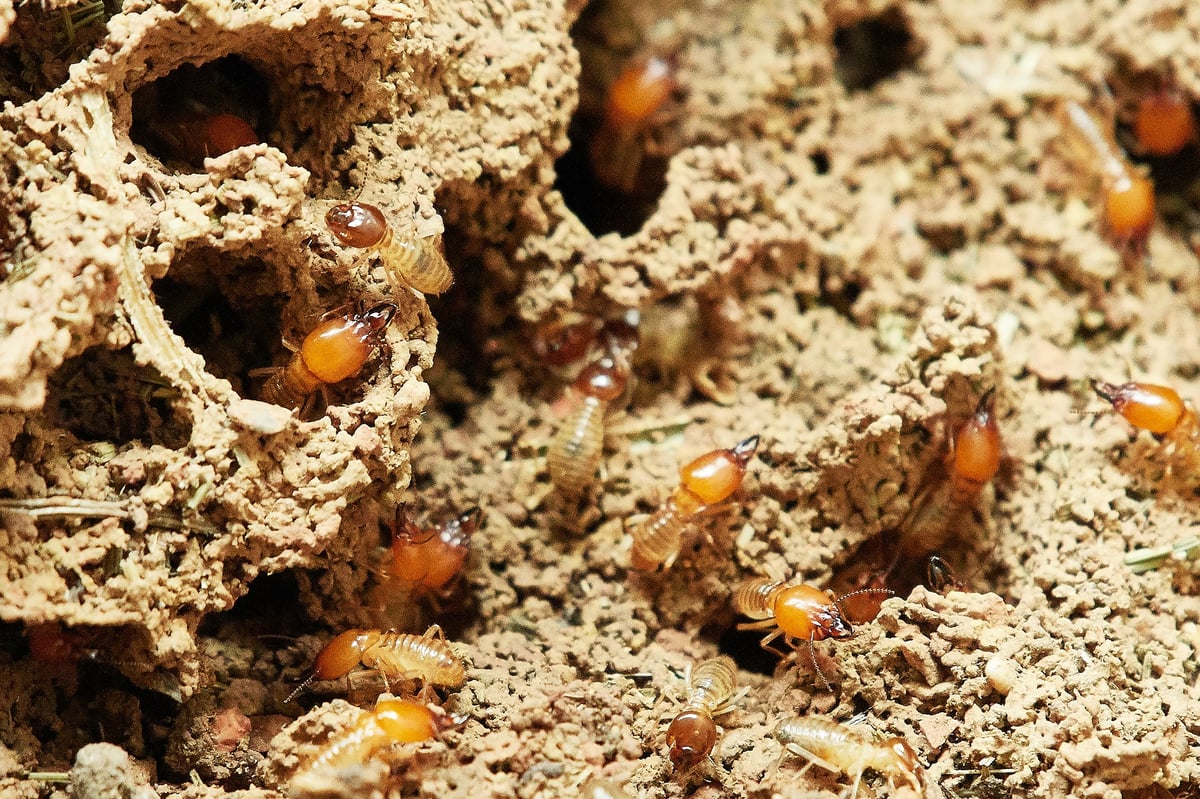 So while they can be chewing on the wood in or around your home all year long, spotting spring swarms can be a sign of termite infestation. As you look for these, remember that winged termites look a lot like winged ants. How you can tell them apart is that termites' wings are equal in length, while the wings on flying ants change from larger in the front set to smaller in the back set. Termites also have thicker bodies compared to ants.
So while they can be chewing on the wood in or around your home all year long, spotting spring swarms can be a sign of termite infestation. As you look for these, remember that winged termites look a lot like winged ants. How you can tell them apart is that termites' wings are equal in length, while the wings on flying ants change from larger in the front set to smaller in the back set. Termites also have thicker bodies compared to ants.
But these distinctions are tough to spot. If you see this type of activity, you may want to contact a professional exterminator for an inspection to confirm your findings.
2. Termite Superhighways
Another sign of termites are the vessels they use to travel in, which are known as mud tubes.
Mud tubes are about ⅛” thick tubes that shelter termites as they travel between their underground colonies and your home to find wood to eat. They keep termites protected and moist.
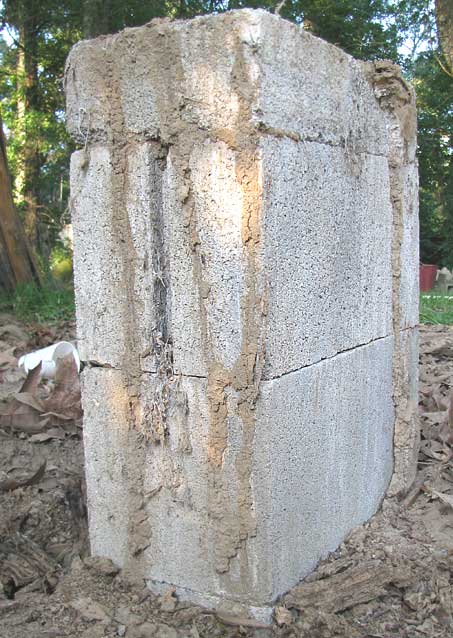 These mud tubes typically extend over foundation walls or support beams. You can find the tunnel trails going along wood, concrete, cinder blocks, or even in mid-air to help the termites reach their destination.
These mud tubes typically extend over foundation walls or support beams. You can find the tunnel trails going along wood, concrete, cinder blocks, or even in mid-air to help the termites reach their destination.
Yes, you’re basically looking for the termite’s version of a highway. If you spot these, it’s a good sign that you have termites nearby.
3. Damaged Wood
Since termites eat wood, an obvious and big sign of termite infestation is damaged wood.
What you’re looking for here is crumbling wood. If you push on it with your finger or a screwdriver, it might cave in because the center is hollow and eaten away by termites.
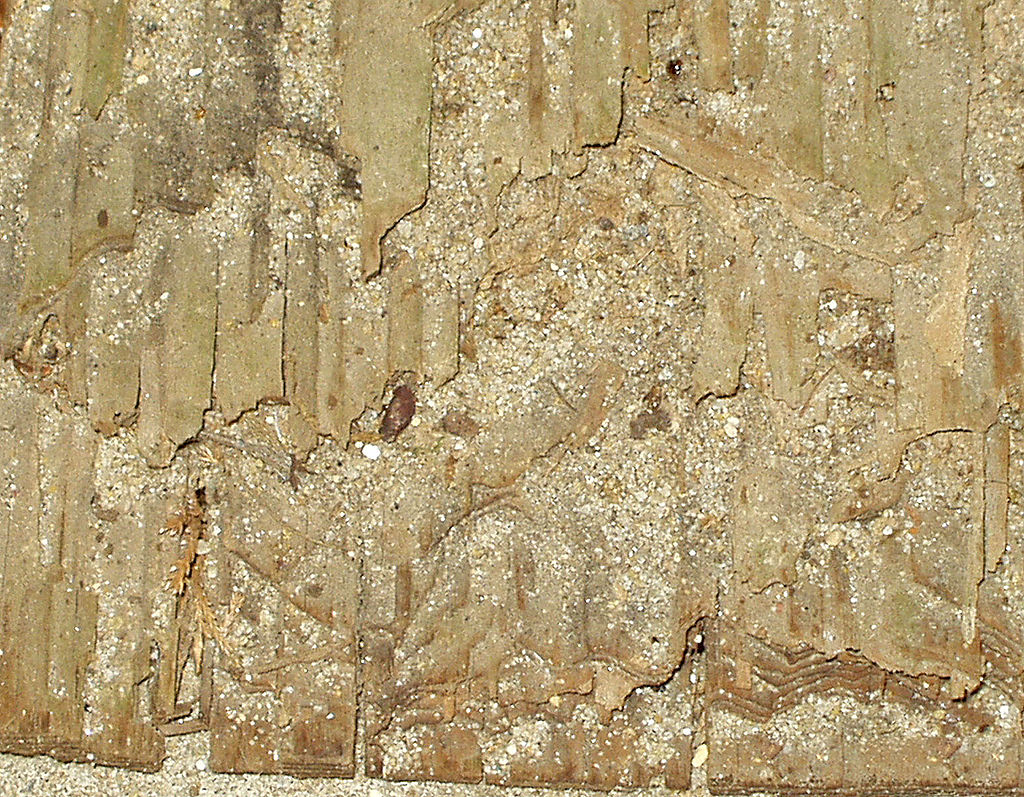 Another thing to look at is the color or texture of your wood. If it’s soft or discolored, try pushing on it to test its strength. If it crumbles under pressure, it’s a possibility termites have been dining there. You might even notice bigger problems like your floor sagging or the wood around your doors or windows wearing and causing issues with closing or opening.
Another thing to look at is the color or texture of your wood. If it’s soft or discolored, try pushing on it to test its strength. If it crumbles under pressure, it’s a possibility termites have been dining there. You might even notice bigger problems like your floor sagging or the wood around your doors or windows wearing and causing issues with closing or opening.
4. The Pests Themselves
An obvious sign of termites is actually spotting these bugs in action themselves.
But this is not an easy task.
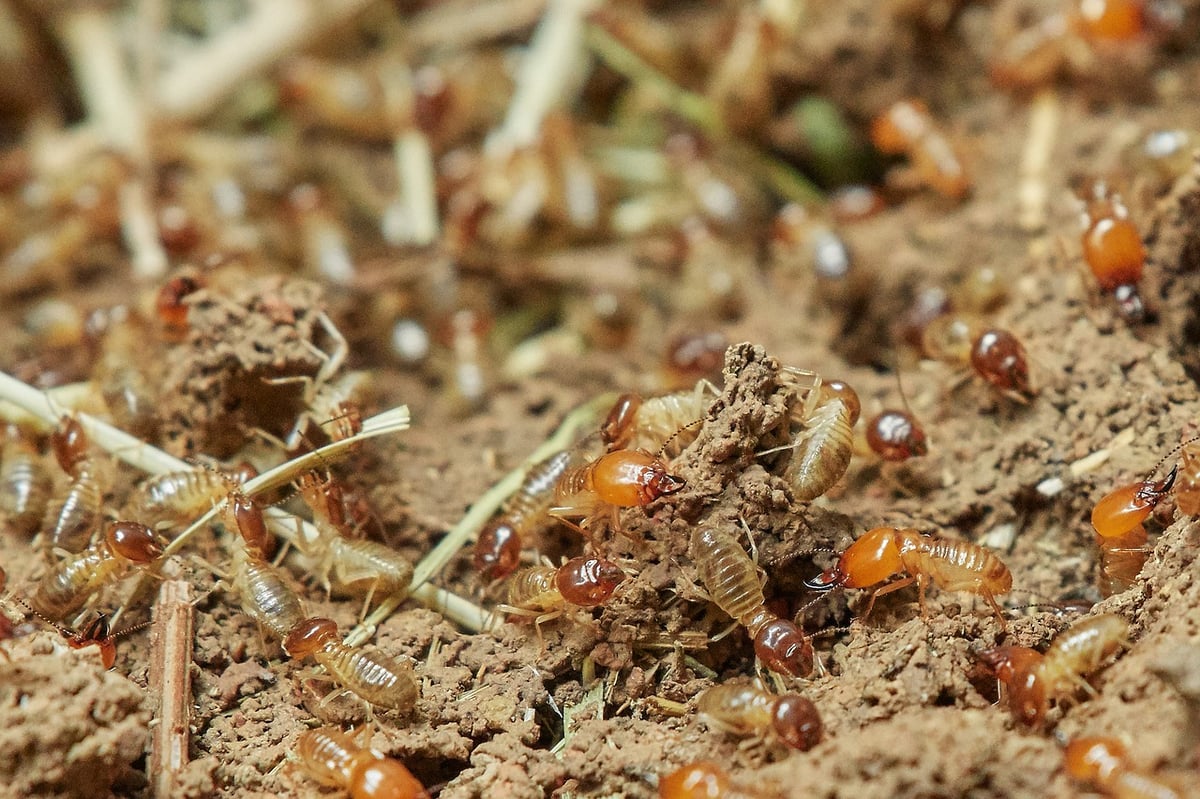 Let’s learn a little bit about what kinds of termites can be present on your property. Usually, you’ll have three types in action: workers, soldiers, and reproducers.
Let’s learn a little bit about what kinds of termites can be present on your property. Usually, you’ll have three types in action: workers, soldiers, and reproducers.
All three of these termite types look the same: white in color and pretty small. Reproductive termites have wings and look a bit like flying ants. All of them are about ¼ of an inch to ⅜ of an inch long.
If You See Termite Signs, a Pro Can Help
If you spot any of these four signs above, you want to act fast to avoid any serious damage to your home.
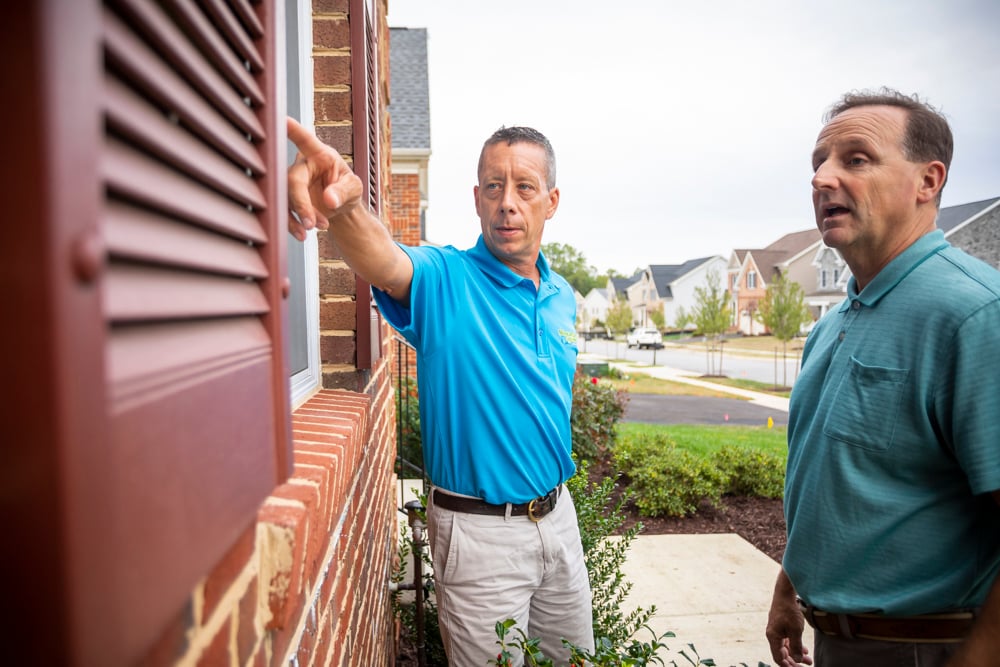 Your first step is to start with a termite inspection. Many pest control companies in Central and Southern Maryland like Natural Green Systems will perform your first termite inspection free unless it’s part of a home inspection or real estate transaction. You’ll want to be home for this to ensure the professional can get inside your home. They’ll need access to the outside and inside, particularly crawl spaces, basements, attics, and garages, which are places they tend to find higher levels of activity.
Your first step is to start with a termite inspection. Many pest control companies in Central and Southern Maryland like Natural Green Systems will perform your first termite inspection free unless it’s part of a home inspection or real estate transaction. You’ll want to be home for this to ensure the professional can get inside your home. They’ll need access to the outside and inside, particularly crawl spaces, basements, attics, and garages, which are places they tend to find higher levels of activity.
Pest control technicians will check the signs of termites you are seeing to confirm that the problem is termites and should be able to tell you whether the infestation is current or past. Then they’ll recommend some control strategies.
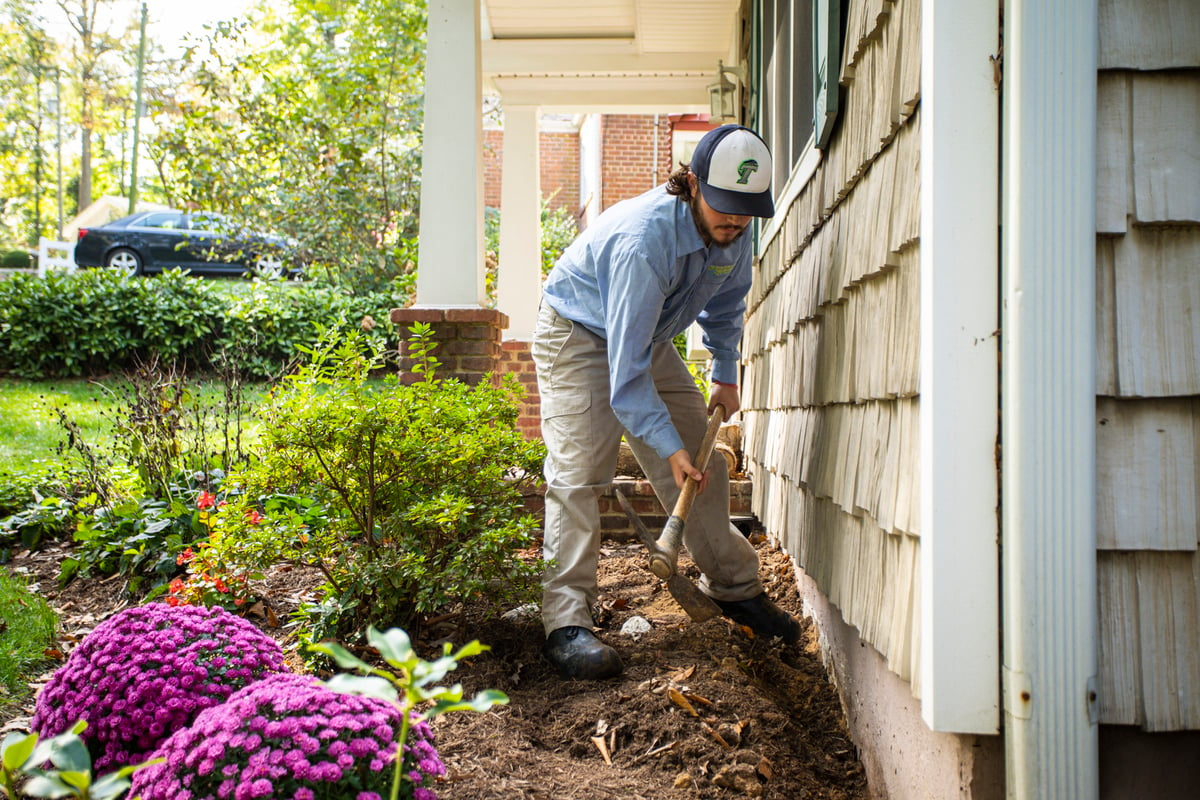 Treatment usually involves a trench-and-rod treatment where they dig a shallow trench around your home’s foundation and insert termiticide every 1.5 to 2 feet along this trench, creating a complete barrier. Termite treatments range from between $10 to $13 per linear feet of your home’s perimeter, including any structures like garages.
Treatment usually involves a trench-and-rod treatment where they dig a shallow trench around your home’s foundation and insert termiticide every 1.5 to 2 feet along this trench, creating a complete barrier. Termite treatments range from between $10 to $13 per linear feet of your home’s perimeter, including any structures like garages.
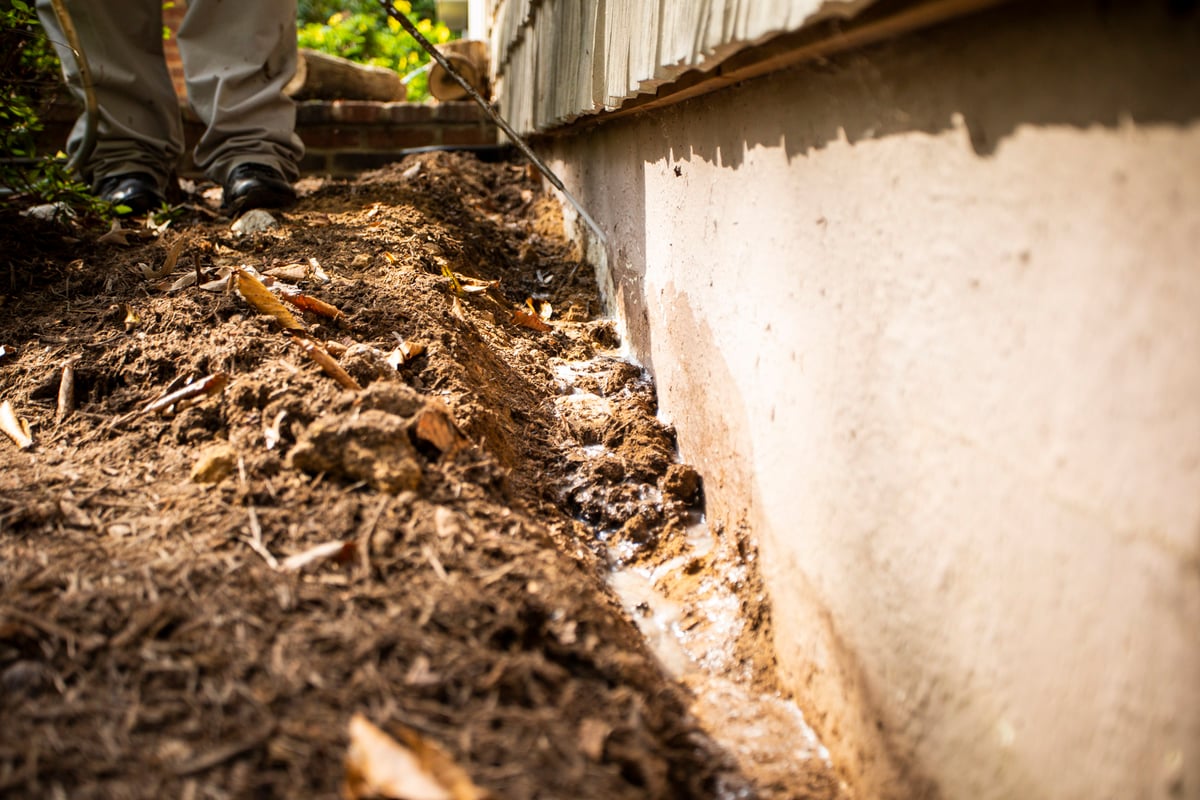 The treatment is guaranteed, as long as you keep up a $125 annual inspection to ensure termites haven’t broken through the barrier, as well as restrengthen areas of the barrier to keep it strong. After finding termites attacking your home, having a professional check your home annually is a great relief to ensure these pests are truly gone.
The treatment is guaranteed, as long as you keep up a $125 annual inspection to ensure termites haven’t broken through the barrier, as well as restrengthen areas of the barrier to keep it strong. After finding termites attacking your home, having a professional check your home annually is a great relief to ensure these pests are truly gone.
Decaying, moist wood is termites’ favorite food group, so keeping an eye for these signs of termites in your house is a great way to ensure your home is protected.
If you’re suspicious termites are attacking your home, it never hurts to have a professional take a look. You want to get ahead of any problems before they get very expensive to repair.
We don’t want you to worry about what’s lurking in your home. Give Natural Green Systems a call today for a free termite inspection. We’ll bring our proven termite control experience and create a custom plan for your Central and Southern Maryland home.  View Pest Control Programs
View Pest Control Programs
Image Source: Termites, Mud Tubes Termites, Damaged Wood, Termites in dirt
Termites may be one of the hardest things to detect whether they are lurking in your home or not.
They could be in your walls or foundation, and you might not even know it. They are pretty sneaky, and that’s just not a great feeling, particularly if you have a sense they are in your home.
You might think you have termites because of damage or weird sounds or sights that make you suspicious. Your home is one of your single biggest investments, and you’re not about to let little pests take it out from under you.
Use This Tool to Compare Your Local Pest Control CompaniesWe understand your concern. Termites cause $50 billion in damage to homes and buildings annually, so they are certainly not something to ignore.
But there are signs of termite infestation you can focus on to confirm your suspicions or ease your worries.
Here is some guidance for spotting termites in Maryland so you can focus your efforts.
4 Signs of Termites
First, while many insects have a season or time of year when they appear most active, termites can be active in your home all year long.
But they are known to swarm in April. What encourages termites to swarm is the warming weather, as well as rain. They will typically swarm after rainfall to ensure they stay hydrated during the process.
Termites swarm when they go in search of mates and to establish a new colony. Colonies themselves typically don’t swarm until they’ve become established; this can take about 3 years.
But other than the possibility of seeing more termites moving about in spring, you may not see termites at all until the damage is done. That’s why it’s important to keep an eye out for these signs of termites in your house.
1. Flying Termites in Spring
So, as we just mentioned, termites tend to swarm In April and May.
This is the time when they fly into the air, drop to the ground, shed their wings, and seek out a mate.
 So while they can be chewing on the wood in or around your home all year long, spotting spring swarms can be a sign of termite infestation. As you look for these, remember that winged termites look a lot like winged ants. How you can tell them apart is that termites' wings are equal in length, while the wings on flying ants change from larger in the front set to smaller in the back set. Termites also have thicker bodies compared to ants.
So while they can be chewing on the wood in or around your home all year long, spotting spring swarms can be a sign of termite infestation. As you look for these, remember that winged termites look a lot like winged ants. How you can tell them apart is that termites' wings are equal in length, while the wings on flying ants change from larger in the front set to smaller in the back set. Termites also have thicker bodies compared to ants.
But these distinctions are tough to spot. If you see this type of activity, you may want to contact a professional exterminator for an inspection to confirm your findings.
2. Termite Superhighways
Another sign of termites are the vessels they use to travel in, which are known as mud tubes.
Mud tubes are about ⅛” thick tubes that shelter termites as they travel between their underground colonies and your home to find wood to eat. They keep termites protected and moist.
 These mud tubes typically extend over foundation walls or support beams. You can find the tunnel trails going along wood, concrete, cinder blocks, or even in mid-air to help the termites reach their destination.
These mud tubes typically extend over foundation walls or support beams. You can find the tunnel trails going along wood, concrete, cinder blocks, or even in mid-air to help the termites reach their destination.
Yes, you’re basically looking for the termite’s version of a highway. If you spot these, it’s a good sign that you have termites nearby.
3. Damaged Wood
Since termites eat wood, an obvious and big sign of termite infestation is damaged wood.
What you’re looking for here is crumbling wood. If you push on it with your finger or a screwdriver, it might cave in because the center is hollow and eaten away by termites.
 Another thing to look at is the color or texture of your wood. If it’s soft or discolored, try pushing on it to test its strength. If it crumbles under pressure, it’s a possibility termites have been dining there. You might even notice bigger problems like your floor sagging or the wood around your doors or windows wearing and causing issues with closing or opening.
Another thing to look at is the color or texture of your wood. If it’s soft or discolored, try pushing on it to test its strength. If it crumbles under pressure, it’s a possibility termites have been dining there. You might even notice bigger problems like your floor sagging or the wood around your doors or windows wearing and causing issues with closing or opening.
4. The Pests Themselves
An obvious sign of termites is actually spotting these bugs in action themselves.
But this is not an easy task.
 Let’s learn a little bit about what kinds of termites can be present on your property. Usually, you’ll have three types in action: workers, soldiers, and reproducers.
Let’s learn a little bit about what kinds of termites can be present on your property. Usually, you’ll have three types in action: workers, soldiers, and reproducers.
All three of these termite types look the same: white in color and pretty small. Reproductive termites have wings and look a bit like flying ants. All of them are about ¼ of an inch to ⅜ of an inch long.
If You See Termite Signs, a Pro Can Help
If you spot any of these four signs above, you want to act fast to avoid any serious damage to your home.
 Your first step is to start with a termite inspection. Many pest control companies in Central and Southern Maryland like Natural Green Systems will perform your first termite inspection free unless it’s part of a home inspection or real estate transaction. You’ll want to be home for this to ensure the professional can get inside your home. They’ll need access to the outside and inside, particularly crawl spaces, basements, attics, and garages, which are places they tend to find higher levels of activity.
Your first step is to start with a termite inspection. Many pest control companies in Central and Southern Maryland like Natural Green Systems will perform your first termite inspection free unless it’s part of a home inspection or real estate transaction. You’ll want to be home for this to ensure the professional can get inside your home. They’ll need access to the outside and inside, particularly crawl spaces, basements, attics, and garages, which are places they tend to find higher levels of activity.
Pest control technicians will check the signs of termites you are seeing to confirm that the problem is termites and should be able to tell you whether the infestation is current or past. Then they’ll recommend some control strategies.
 Treatment usually involves a trench-and-rod treatment where they dig a shallow trench around your home’s foundation and insert termiticide every 1.5 to 2 feet along this trench, creating a complete barrier. Termite treatments range from between $10 to $13 per linear feet of your home’s perimeter, including any structures like garages.
Treatment usually involves a trench-and-rod treatment where they dig a shallow trench around your home’s foundation and insert termiticide every 1.5 to 2 feet along this trench, creating a complete barrier. Termite treatments range from between $10 to $13 per linear feet of your home’s perimeter, including any structures like garages.
 The treatment is guaranteed, as long as you keep up a $125 annual inspection to ensure termites haven’t broken through the barrier, as well as restrengthen areas of the barrier to keep it strong. After finding termites attacking your home, having a professional check your home annually is a great relief to ensure these pests are truly gone.
The treatment is guaranteed, as long as you keep up a $125 annual inspection to ensure termites haven’t broken through the barrier, as well as restrengthen areas of the barrier to keep it strong. After finding termites attacking your home, having a professional check your home annually is a great relief to ensure these pests are truly gone.
Decaying, moist wood is termites’ favorite food group, so keeping an eye for these signs of termites in your house is a great way to ensure your home is protected.
If you’re suspicious termites are attacking your home, it never hurts to have a professional take a look. You want to get ahead of any problems before they get very expensive to repair.
We don’t want you to worry about what’s lurking in your home. Give Natural Green Systems a call today for a free termite inspection. We’ll bring our proven termite control experience and create a custom plan for your Central and Southern Maryland home.  View Pest Control Programs
View Pest Control Programs
Image Source: Termites, Mud Tubes Termites, Damaged Wood, Termites in dirt
Share This
Topics: Pest Control

